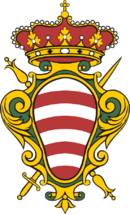New Renaissance Party: Difference between revisions
No edit summary |
No edit summary |
||
| Line 34: | Line 34: | ||
==History== | ==History== | ||
===Renaissance Society=== | ===Granzerian Renaissance Society=== | ||
The origins of the Granzerian Renaissance party exists in the organization known as the ''Granzerian Renaissance Society'', an underground far right nationalist organization founded in opposition to the Granzerian communist government which had existed since the 1930s. The Renaissance Society was founded in 1968 by founding members Istvan Kende, Viktor Szombathy and Jóska Faragó in Győr-Ibrany. For ten years the Renaissance society remained a fairly small, underground formation which flew mostly under the radar from the Granzerian State security apparatus, such as the [[Bureau for Counter-revolutionary Affairs|EÜI]] and [[State Continuity Council (Granzery)|AFT]]. By 1978 the Renaissance Society had grown to just over 2,000 signed members and in 1978 three GRS members detonated a fertilizer car bomb killing then Granzerian Head of State Premier [[Ármin Dunai]]. This began a crackdown on the organization with over 600 members arrested over the course of the next few weeks, including co-founder Jóska Faragó who was shot dead by EUI troopers in 1979. | The origins of the Granzerian Renaissance party exists in the organization known as the ''Granzerian Renaissance Society'', an underground far right nationalist organization founded in opposition to the Granzerian communist government which had existed since the 1930s. The Renaissance Society was founded in 1968 by founding members Istvan Kende, Viktor Szombathy and Jóska Faragó in Győr-Ibrany. For ten years the Renaissance society remained a fairly small, underground formation which flew mostly under the radar from the Granzerian State security apparatus, such as the [[Bureau for Counter-revolutionary Affairs|EÜI]] and [[State Continuity Council (Granzery)|AFT]]. By 1978 the Renaissance Society had grown to just over 2,000 signed members and in 1978 three GRS members detonated a fertilizer car bomb killing then Granzerian Head of State Premier [[Ármin Dunai]]. This began a crackdown on the organization with over 600 members arrested over the course of the next few weeks, including co-founder Jóska Faragó who was shot dead by EUI troopers in 1979. | ||
The death of Faragó, and ongoing disputes regarding tactics between Kende and Szombathy, led to the dissolution of the GRS, with Kende going on to found the New Renaissance Society, a primarily political group, and Szombathy then founding the Granzerian Nationalist Resistance Movement, or GRANEM for short, a paramilitary group designated a terror organization by the then Granzerian government. | The death of Faragó, and ongoing disputes regarding tactics between Kende and Szombathy, led to the dissolution of the GRS, with Kende going on to found the New Renaissance Society, a primarily political group, and Szombathy then founding the Granzerian Nationalist Resistance Movement, or GRANEM for short, a paramilitary group designated a terror organization by the then Granzerian government. | ||
===New Renaissance Party=== | |||
Despite the losses at the tail end of the 1970s, the New Renaissance party enjoyed a surge of popularity and membership during a period of liberalism by the Granzerian communist government. | |||
{{Template:Granzery Topics}} | {{Template:Granzery Topics}} | ||
Revision as of 04:08, 29 March 2022
This article is incomplete because it is pending further input from participants, or it is a work-in-progress by one author. Please comment on this article's talk page to share your input, comments and questions. Note: To contribute to this article, you may need to seek help from the author(s) of this page. |
New Renaissance Party Új Reneszánsz Párt | |
|---|---|
 | |
| Chairman | Karoly Taksony (Vezér) |
| Secretary-General | Istvan Kecel (Prime Minister) |
| General Under-Secretary | Bonifác Veres |
| Secretary of the Political Reformation Committee | Szilveszter Péter |
| Secretary of the Internal Security Commission | Kristóf Kalmár |
| Founded | 6 June 2015 |
| Headquarters | Győr-Ibrany |
| Ideology | Anti-liberalism Anti-communism National Conservatism Social Conservatism Nationalism Fascist corporatism Paternalistic conservatism |
| Political position | Far-right |
| Colours | Rose White |
| Seats in the Senate | 124 / 200
|
| Seats in the Vezekabinet | 109 / 109
|
| Website | |
| www.reneszánsz.grz | |
The New Renaissance Party (Granzerian: Új Reneszánsz Párt) is a political party in the National Republic Granzery. It is the current ruling party of Granzery and was formed in the 6th of June 1987 following the seizure of power in Granzery by then Vezér, Istvan Kende.
History
Granzerian Renaissance Society
The origins of the Granzerian Renaissance party exists in the organization known as the Granzerian Renaissance Society, an underground far right nationalist organization founded in opposition to the Granzerian communist government which had existed since the 1930s. The Renaissance Society was founded in 1968 by founding members Istvan Kende, Viktor Szombathy and Jóska Faragó in Győr-Ibrany. For ten years the Renaissance society remained a fairly small, underground formation which flew mostly under the radar from the Granzerian State security apparatus, such as the EÜI and AFT. By 1978 the Renaissance Society had grown to just over 2,000 signed members and in 1978 three GRS members detonated a fertilizer car bomb killing then Granzerian Head of State Premier Ármin Dunai. This began a crackdown on the organization with over 600 members arrested over the course of the next few weeks, including co-founder Jóska Faragó who was shot dead by EUI troopers in 1979.
The death of Faragó, and ongoing disputes regarding tactics between Kende and Szombathy, led to the dissolution of the GRS, with Kende going on to found the New Renaissance Society, a primarily political group, and Szombathy then founding the Granzerian Nationalist Resistance Movement, or GRANEM for short, a paramilitary group designated a terror organization by the then Granzerian government.
New Renaissance Party
Despite the losses at the tail end of the 1970s, the New Renaissance party enjoyed a surge of popularity and membership during a period of liberalism by the Granzerian communist government.
